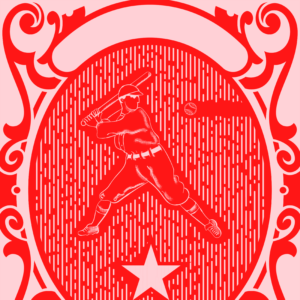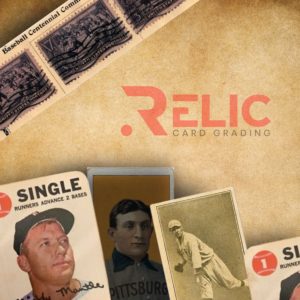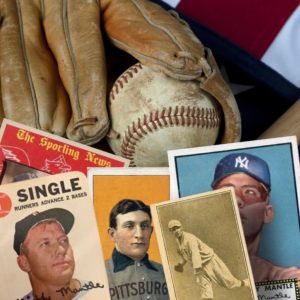
Tag: Baseball Card History

Baseball Cards in the Post-War Era – Enter the 1950s
- Post author By Relic Card Grading
- Post date August 22, 2023
- No Comments on Baseball Cards in the Post-War Era – Enter the 1950s


Post-War Era Baseball Cards & The Introduction of Topps
The post-war era, particularly the 1950s, was a transformative period for America, marked by renewed optimism and rapid growth. For the world of baseball cards, this decade represented a renaissance of sorts, redefining the hobby for generations to come. The 1950s, or the post-war era of baseball cards, changed the way baseball cards were produced, viewed, and collected.
Topps Emerges as the Gold Standard in Baseball Cards
When modern-day collectors and hobbyists think of baseball cards, one name instantly comes to mind – Topps (affiliate link). But have you ever wondered about the origins of this iconic brand and how the brand evolved over time?
Believe it or not, Topps didn’t start out as a baseball card company. Established in 1938, The Topps Company, Inc. began its journey as a family gum enterprise. Yes, you read that right! Before they became synonymous with baseball memorabilia, Topps was busy producing Bazooka bubble gum.
It wasn’t until 1951 that Topps ventured into baseball cards. Their inaugural sets were quaintly named “Blue Backs” and “Red Backs” based on the color schemes on the back of the cards.
But the real game-changer came in 1952. That year, Topps released a set that would forever be etched in the annals of baseball card history. This set featured a young Mickey Mantle, a card that remains a Holy Grail for collectors today. Besides its memorable roster of players, the 1952 Topps set is also celebrated for standardizing the dimensions of the modern sports card – a size of 2.5 by 3.5 inches, which is still in use. The 1952 Topps baseball card checklist can be found below.
From its inception as a humble gum producer to its esteemed status as a trading card behemoth, Topps has been a game-changer. Over the decades, they’ve given us treasured baseball cards and expanded their repertoire, capturing the magic of various sports and entertainment phenomena.
So, the next time you hold a Topps card, remember, you’re not just holding a card, but a slice of history.
1952 Topps Baseball Card Checklist Cards
1 Andy Pafko
2 James E. Runnels
3 Hank Thompson
4 Don Lenhardt
5 Larry Jansen
6 Joe Hatten
7 Wayne Terwilliger
8 Fred Marsh
9 Bobby Hogue
10 Al Rosen
11 Phil Rizzuto
12 Monty Basgall
13 Johnny Wyrostek
14 Bob Elliott
15 Johnny Pesky
16 Gene Hermanski
17 Jim Hegan
18 Merrilll Combs
19 Johnny Bucha
20 Billy Loes
21 Ferris Fain
22 Dom DiMaggio
23 Billy Goodman
24 Luke Easter
25 Johnny Groth
26 Monte Irvin
27 Sam Jethroe
28 Jerry Priddy
29 Ted Kluszewski
30 Mel Parnell
31 Gus Zernial
32 Eddie Robinson
33 Warren Spahn
34 Elmer Valo
35 Hank Sauer
36 Gil Hodges
37 Duke Snider
38 Wally Westlake
39 Dizzy Trout
40 Irv Noren
41 Bob Wellman
42 Lou Kretlow
43 Ray Scarborough
44 Con Dempsey
45 Eddie Joost
46 Gordon Goldsberry
47 Willie Jones
48 Joe Page
49 Johnny Sain
50 Marv Rickert
51 Jim Russell
52 Don Mueller
53 Chris Van Cuyk
54 Leo Kiely
55 Ray Boone
56 Tommy Glaviano
57 Ed Lopat
58 Bob Mahoney
59 Robin Roberts
60 Sid Hudson
61 Tookie Gilbert
62 Chuck Stobbs
63 Howie Pollet
64 Roy Sievers
65 Enos Slaughter
66 Preacher Roe
67 Allie Reynolds
68 Cliff Chambers
69 Virgil Stallcup
70 Al Zarilla
71 Tom Upton
72 Karl Olson
73 William Werle
74 Andy Hansen
75 Wes Westrum
76 Eddie Stanky
77 Bob Kennedy
78 Ellis Kinder
79 Gerald Staley
80 Herm Wehmeier
81 Vernon Law
82 Duane Pillette
83 Billy Johnson
84 Vern Stephens
85 Bob Kuzava
86 Ted Gray
87 Dale Coogan
88 Bob Feller
89 Johnny Lipon
90 Mickey Grasso
91 Red Schoendienst
92 Dale Mitchell
93 Al Sima
94 Sam Mele
95 Ken Holcombe
96 Willard Marshall
97 Earl Torgeson
98 Bill Pierce
99 Gene Woodling
100 Del Rice
101 Max Lanier
102 Bill Kennedy
103 Cliff Mapes
104 Don Kolloway
105 John Pramesa
106 Mickey Vernon
107 Connie Ryan
108 Jim Konstanty
109 Ted Wilks
110 Dutch Leonard
111 Harry Lowrey
112 Henry Majeski
113 Dick Sisler
114 Willard Ramsdell
115 George Munger
116 Carl Scheib
117 Sherman Lollar
118 Ken Raffensberger
119 Maurice McDermott
120 Bob Chakales
121 Gus Niarhos
122 Jack Jensen
123 Eddie Yost
124 Monte Kennedy
125 Bill Rigney
126 Fred Hutchinson
127 Paul Minner
128 Don Bollweg
129 Johnny Mize
130 Sheldon Jones
131 Morrie Martin
132 Clyde Kluttz
133 Al Widmar
134 Joe Tipton
135 Dixie Howell
136 Johnny Schmitz
137 Roy McMillan
138 Bill MacDonald
139 Ken Wood
140 Johnny Antonelli
141 Clint Hartung
142 Harry Perkowski
143 Les Moss
144 Ed Blake
145 Joe Haynes
146 Frank House
147 Bob Young
148 Johnny Klippstein
149 Dick Kryhoski
150 Ted Beard
151 Wally Post
152 Al Evans
153 Bob Rush
154 Joe Muir
155 Frank Overmire
156 Frank Hiller
157 Bob Usher
158 Eddie Waitkus
159 Saul Rogovin
160 Owen Friend
161 Bud Byerly
162 Del Crandall
163 Stan Rojek
164 Walt Dubiel
165 Eddie Kazak
166 Paul LaPalme
167 Bill Howerton
168 Charlie Silvera
169 Howie Judson
170 Gus Bell
171 Ed Erautt
172 Eddie Miksis
173 Roy Smalley
174 Clarence Marshall
175 Billy Martin
176 Hank Edwards
177 Bill Wight
178 Cass Michaels
179 Frank Smith
180 Charley Maxwell
181 Bob Swift
182 Billy Hitchcock
183 Erv Dusak
184 Bob Ramazzotti
185 Bill Nicholson
186 Walt Masterson
187 Bob Miller
188 Clarence Podbielan
189 Pete Reiser
190 Don Johnson
191 Yogi Berra
192 Myron Ginsberg
193 Harry Simpson
194 Joe Hatten
195 Orestes Minoso
196 Solly Hemus
197 George Strickland
198 Phil Haugstad
199 George Zuverink
200 Ralph Houk
201 Alex Kellner
202 Joe Collins
203 Curt Simmons
204 Ron Northey
205 Clyde King
206 Joe Ostrowski
207 Mickey Harris
208 Marlin Stuart
209 Howie Fox
210 Dick Fowler
211 Ray Coleman
212 Ned Garver
213 Nippy Jones
214 Johnny Hopp
215 Hank Bauer
216 Richie Ashburn
217 George Stirnweiss
218 Clyde McCullough
219 Bobby Shantz
220 Joe Presko
221 Granny Hamner
222 Hoot Evers
223 Del Ennis
224 Bruce Edwards
225 Frank Baumholtz
226 Dave Philley
227 Joe Garagiola
228 Al Brazle
229 Gene Bearden
230 Matt Batts
231 Sam Zoldak
232 Billy Cox
233 Bob Friend
234 Steve Souchock
235 Walt Dropo
236 Ed Fitz Gerald
237 Jerry Coleman
238 Art Houtteman
239 Rocky Bridges
240 Jack Phillips
241 Tommy Byrne
242 Tom Poholsky
243 Larry Doby
244 Vic Wertz
245 Sherry Robertson
246 George Kell
247 Randy Gumpert
248 Frank Shea
249 Bobby Adams
250 Carl Erskine
251 Chico Carrasquel
252 Vern Bickford
253 Johnny Berardino
254 Joe Dobson
255 Clyde Vollmer
256 Pete Suder
257 Bobby Avila
258 Steve Gromek
259 Bob Addis
260 Pete Castiglione
261 Willie Mays
262 Virgil Trucks
263 Harry Brecheen
264 Roy Hartsfield
265 Chuck Diering
266 Murry Dickson
267 Sid Gordon
268 Bob Lemon
269 Willard Nixon
270 Lou Brissie
271 Jim Delsing
272 Mike Garcia
273 Erv Palica
274 Ralph Branca
275 Pat Mullin
276 Jim Wilson
277 Early Wynn
278 Allie Clark
279 Ed Stewart
280 Cloyd Boyer
281 Tommy Brown
282 Birdie Tebbetts
283 Phil Masi
284 Hank Arft
285 Cliff Fannin
286 Joe DeMaestri
287 Steve Bilko
288 Chet Nichols
289 Tommy Holmes
290 Joe Astroth
291 Gil Coan
292 Floyd Baker
293 Sibby Sisti
294 Walker Cooper
295 Phil Cavarretta
296 Red Rolfe
297 Andy Seminick
298 Bob Ross
299 Ray Murray
300 Barney McCosky
301 Bob Porterfield
302 Max Surkont
303 Harry Dorish
304 Sam Dente
305 Paul Richards
306 Lou Sleater
307 Frank Campos
308 Luis Aloma
309 Jim Busby
310 George Metkovich
311 Mickey Mantle
312 Jackie Robinson
313 Bobby Thomson
314 Roy Campanella
315 Leo Durocher
316 Davey Williams
317 Connie Marrero
318 Hal Gregg
319 Al Walker
320 John Rutherford
321 Joe Black
322 Randy Jackson
323 Bubba Church
324 Warren Hacker
325 Bill Serena
326 George Shuba
327 Archie Wilson
328 Bob Borkowski
329 Ivan Delock
330 Turk Lown
331 Tom Morgan
332 Tony Bartirome
333 Pee Wee Reese
334 Wilmer Mizell
335 Ted Lepcio
336 Dave Koslo
337 Jim Hearn
338 Sal Yvars
339 Russ Meyer
340 Bob Hooper
341 Hal Jeffcoat
342 Clem Labine
343 Dick Gernert
344 Ewell Blackwell
345 Sam White
346 George Spencer
347 Joe Adcock
348 Bob Kelly
349 Bob Cain
350 Cal Abrams
351 Al Dark
352 Karl Drews
353 Bob Del Greco
354 Fred Hatfield
355 Bobby Morgan
356 Toby Atwell
357 Smoky Burgess
358 Johnny Kucab
359 Dee Fondy
360 George Crowe
361 Bill Posedel
362 Ken Heintzelman
363 Dick Rozek
364 Clyde Sukeforth
365 Cookie Lavagetto
366 Dave Madison
367 Bob Thorpe
368 Ed Wright
369 Dick Groat
370 Billy Hoeft
371 Bob Hofman
372 Gil McDougald
373 Jim Turner
374 Al Benton
375 Jack Merson
376 Faye Throneberry
377 Chuck Dressen
378 Les Fusselman
379 Joe Rossi
380 Clem Koshorek
381 Milton Stock
382 Sam Jones
383 Del Wilber
384 Frankie Crosetti
385 Herman Franks
386 Eddie Yuhas
387 Billy Meyer
388 Bob Chipman
389 Ben Wade
390 Glenn Nelson
391 Ben Chapman
392 Hoyt Wilhelm
393 Ebba St. Claire
394 Billy Herman
395 Jake Pitler
396 Dick Williams
397 Woody Main
398 Hal Rice
399 Jim Fridley
400 Bill Dickey
401 Bob Schultz
402 Earl Harrist
403 Bob Miller
404 Dick Brodowski
405 Eddie Pellagrini
406 Joe Nuxhall
407 Eddie Mathews
1952 Topps Card Values - Most Valuable Edition
The 1952 Topps collection contains some highly-valuable baseball cards. The most sought-after and most valuable cards in this set include the following cards: Mickey Mantle (311), Jackie Robinson (312), Willie Mays (261), Roy Campanella (314), Pee Wee Reese (333), Yogi Bera (191). However, if in good condition, many authentic cards from the 1952 Topps set will fetch a fair price.
Conclusion
Baseball cards have always been more than just pieces of cardboard. They represent eras, memories, and histories of baseball legends and iconic moments. As we journey through the annals of baseball card history, we’ll discover their evolution, from simple marketing tools to coveted collectibles, and how they’ve stood the test of time.
MORE FROM THE "HISTORY OF BASEBALL CARDS IN AMERCIA" SERIES

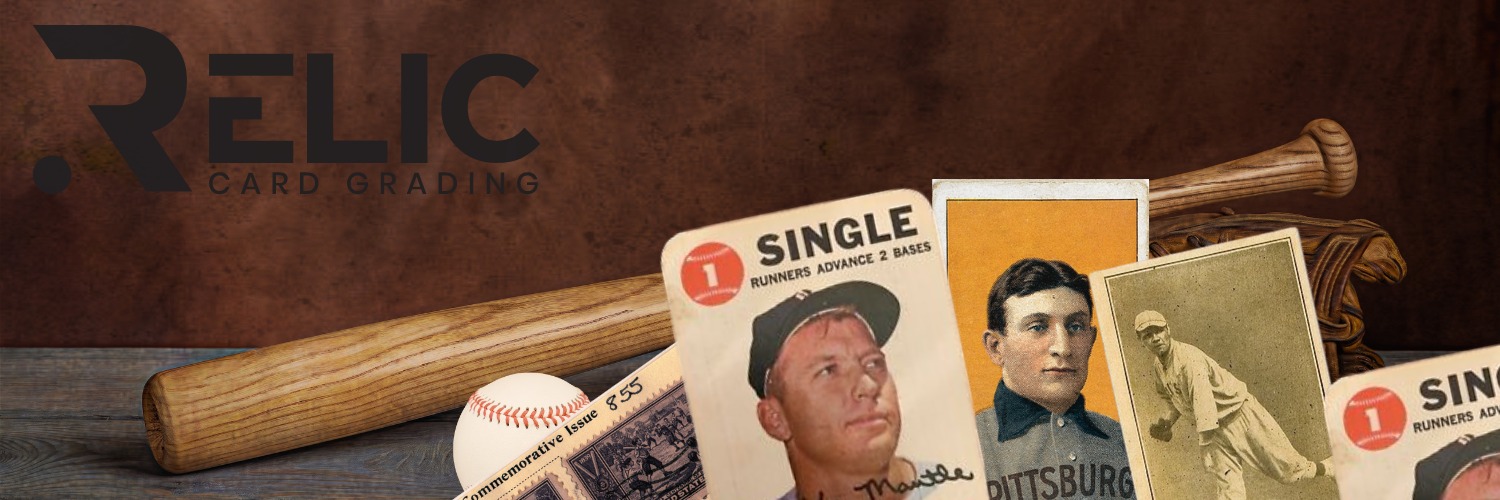
INTRO TO THE ICONS OF PRE-WAR BASEBALL CARDS
As discussed in the first part of our “History of Baseball Cards in America” series, the era defining the term “pre-war” card(s) varies depending on the collector, hobbyist, or historian. However, while pinpointing the exact era that defines “pre-war” cards may be confusing and equally complicated, there’s one thing that holds true; the early years of baseball cards are rooted in capturing iconic images of baseball icons who played pivotal roles in shaping baseball history. From the illustrious Honus Wagner to the unmatched prowess of Babe Ruth, this era saw legends who are still revered today.
Honus Wagner: The Flying Dutchman
No discussion of pre-war baseball cards is complete without acknowledging the T206 Honus Wagner card. While the card itself is iconic, Wagner’s influence on the sport is equally monumental. Known as the “Flying Dutchman,” Wagner’s skill on the field was unparalleled during his time, and his card remains a Holy Grail for many collectors. While scarcity of early Honus Wagner cards plays a major role in their present- day value, his accolades are also a major contributing factor. Here are some of Wagner’s accomplishments:
Hall of Famer: Wagner was part of the inaugural class of inductees into the Baseball Hall of Fame in 1936, alongside other legends like Babe Ruth, Ty Cobb, Christy Mathewson, and Walter Johnson.
Batting Titles: Wagner won eight National League batting titles (1900, 1903, 1904, 1907, 1908, 1909, 1911, and 1912). This ties him with Tony Gwynn for the most in NL history, and only Ty Cobb has more overall with 12.
World Series Champion: He played a pivotal role in the Pittsburgh Pirates’ victory in the 1909 World Series against the Detroit Tigers.
Career Statistics: In his career, Wagner accumulated over 3,400 hits, a .327 lifetime batting average, and stole 722 bases.
Versatile Player: Beyond his abilities at the plate, Wagner was known for his strong arm, range, and versatility. While he’s best remembered as a shortstop, he played every position except catcher during his career.
Baseball Card: His T206 baseball card, produced from 1909 to 1911, is one of the rarest and most valuable baseball cards ever made. Its scarcity is largely due to Wagner’s request to remove it from cigarette packs, possibly because he didn’t want to encourage smoking among young fans.
Legacy: Wagner’s number 33 is retired by the Pittsburgh Pirates, and he is often cited in discussions about the greatest baseball players of all time.
Coaching: After retiring as a player, Wagner served as a hitting coach for the Pirates, nurturing younger players and passing on his knowledge of the game.
Longevity: Wagner’s 21-season playing career was quite lengthy for his era, demonstrating both his talent and his durability.
Recognition: In 1999, he was named to the Major League Baseball All-Century Team, solidifying his legacy as one of the game’s all-time greats.
Throughout his life and career, Wagner was also known for his humility, sportsmanship, and integrity, making him not only a great player but a revered figure in the annals of baseball history.
Babe Ruth: The Sultan of Swat
Then came Babe Ruth, a figure synonymous with baseball’s Golden Age. His prodigious home runs and charismatic personality were immortalized on many cards of the time. Ruth wasn’t just a baseball player; he was an era-defining icon. The Topps baseball cards, and other card brands, bearing his image, are some of the most sought-after collectibles today. Babe Ruth’s accomplishments led to a litany of nicknames, including:
- The Bambino: Arguably his most famous nickname derived from the Italian word for “baby.”
- The Sultan of Swat: A nod to his impressive power and ability to hit home runs.
- The Big Bam: Another reference to his hitting prowess.
- The Colossus of Clout: An alliteration describing his unmatched baseball skill and influence.
- The King of Crash: A nod to the force and frequency of his home runs.
- The Great Bambino: A variation of “The Bambino” nickname.
While these nicknames vary, they all share a common theme: they pay homage to Babe Ruth’s unparalleled skills, larger-than-life personality, and legendary status in baseball.
Say Hello to "Shoeless" Joe & the Black Sox Scandal
“Shoeless” Joe Jackson received his unique nickname from an incident during his early baseball days. The story goes:
While playing for the Greenville Spinners in South Carolina, a minor league team, Jackson had bought a new pair of cleats. During one particular game, these cleats gave him painful blisters on his feet. The discomfort became so unbearable that when he came up to bat, he removed the cleats and stepped up to the plate in his stocking feet.
A fan in the stands reportedly shouted, “you shoeless son of a gun!” or something to that effect, referring to Jackson playing without his shoes on. Other attendees and players caught onto this, and the nickname “Shoeless Joe” stuck.
The “Black Box” Scandal
The “Black Sox” scandal revolves around the 1919 World Series between the Chicago White Sox and the Cincinnati Reds. Eight members of the Chicago team were accused of intentionally losing games in exchange for money from gamblers.
The Players Involved included:
- Eddie Cicotte
- Claude “Lefty” Williams
- Arnold “Chick” Gandil
- Oscar “Happy” Felsch
- George “Buck” Weaver
- Charles “Swede” Risberg
- Fred McMullin
- “Shoeless” Joe Jackson
Of these, Joe Jackson is perhaps the most famous, as he was one of the top players of his era.
Outcome: The scandal came to light in 1920, and while the accused players were acquitted of criminal charges in a 1921 trial, all eight were banned from professional baseball for life by Commissioner Kenesaw Mountain Landis. This decision remains controversial, especially in the case of “Shoeless” Joe Jackson, who many believe may have been innocent or less complicit than the others.
Impact: The Black Sox Scandal had a profound impact on baseball. It led to the appointment of the first Commissioner of Baseball, Kenesaw Mountain Landis, and the establishment of a centralized authority in baseball to maintain the sport’s integrity. The scandal also led to a series of measures designed to reaffirm public confidence in the game’s legitimacy and prevent such incidents in the future.
Despite Jackson’s alleged involvement in the Blac Sox Scandal, or maybe partially attributed to it, many of his cards are extremely sought-after by collectors. His Cracker Jack cards from 1915, featuring various images of Jackson, set against a fiery red background, remain to be some of the most desired cards from this period.
Ty Cobb: The Georgia Peach
Ty Cobb, known for his aggressive playing style and impressive career batting average, was another icon of this era. His cards, especially those in the T206 series, are revered not only for their representation of Cobb but also for the variations in backgrounds and poses.
Other Baseball Luminaries of the Pre-War Era
While Wagner, Ruth, Jackson, and Cobb are giants of the era, many other players left indelible marks. Players like Jackie Robinson, who broke racial barriers, and Lou Gehrig, known for his humility and consistency, were all critical figures of this age. Their contributions, both on the field and as card staples, shaped the baseball card hobby and the sport in countless ways.
Conclusion
Baseball cards from the pre-war era are more than just collectibles; they’re historical artifacts. Through them, we can trace societal changes, from the design and production intricacies due to wartime constraints to the evolving aesthetics matching the nation’s mood. These cards offer a lens through which to view baseball’s and America’s history. As we journey through baseball card history, the pre-war era stands out as a beacon, showcasing legendary players who transcended the sport. Their cards, coveted by collectors, are testaments to their lasting legacy.
MORE FROM THE "HISTORY OF BASEBALL CARDS IN AMERCIA" SERIES
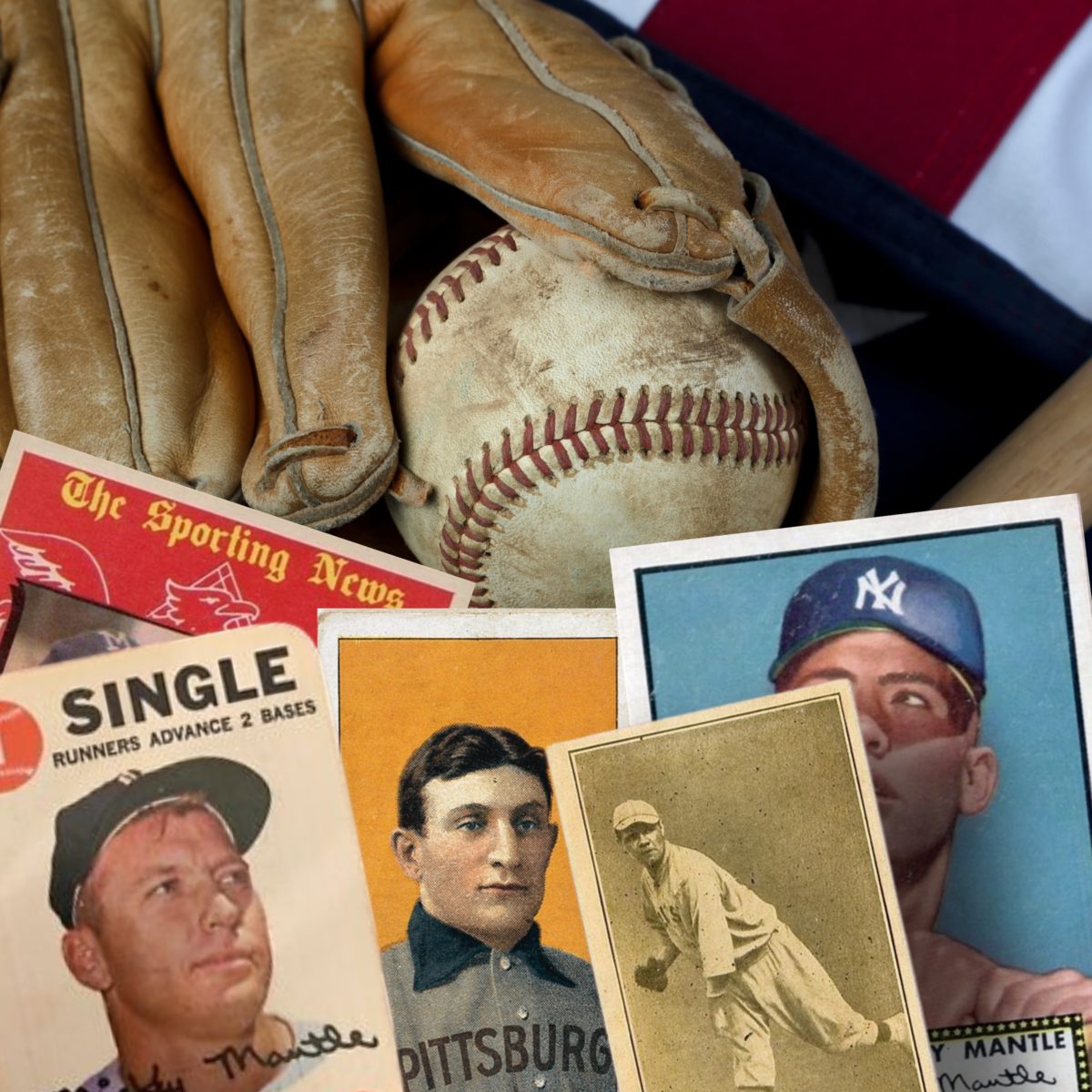
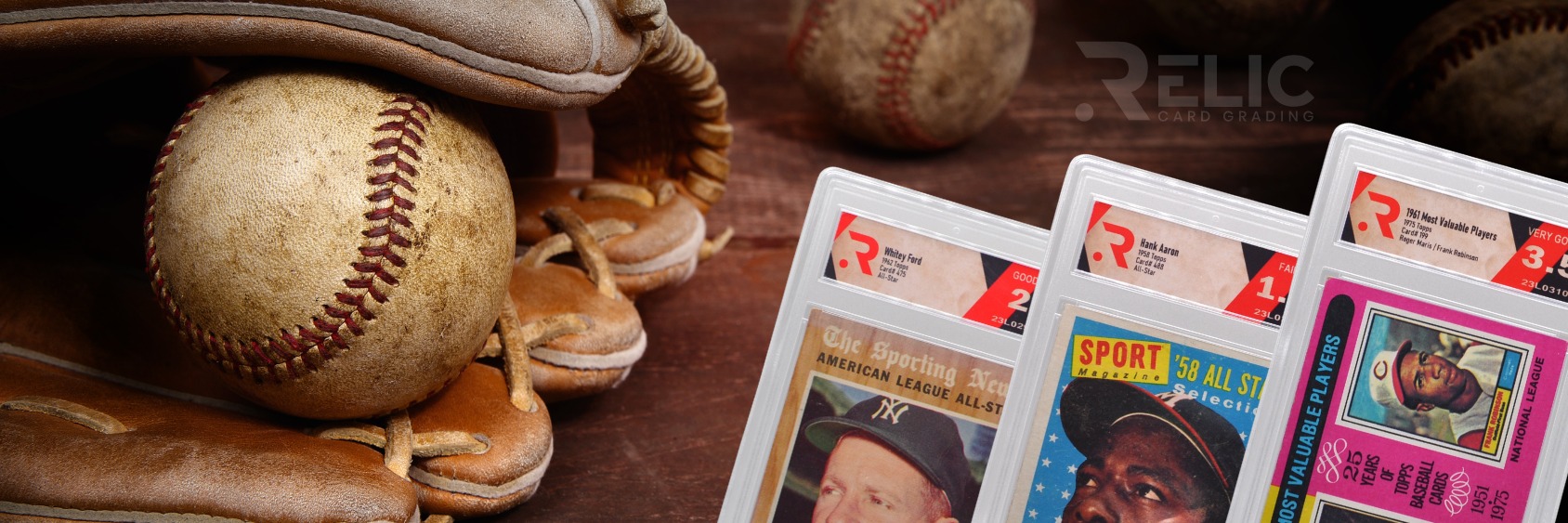
SECTION 1: AN INTRODUCTION TO BASEBALL CARD IN AMERICA
Baseball cards have evolved immensely over the years. From simple tobacco pack inserts to today’s highly sought-after Topps collections, these cards are a testament to America’s enduring passion for baseball. The tradition of collecting, trading, and investing in baseball cards has strong roots in American culture and the evolution of this hobby is nothing short of amazing. In this article, we will introduce you to a variety of transformational events that shaped the baseball card, and sports card industry as a whole, into what it is today.
The Inception of Baseball Cards
Before they became prized possessions safely kept in penny sleeves, top-loaders, special trading card binders, magnetic holders, and graded slabs, baseball cards had a rather modest inception. Born in the late 19th century, they initially accompanied tobacco products. Serving as stiffeners for cigarette packs, these cards doubled as advertisements for tobacco brands. Each card featuring players from different baseball teams not only promoted the brand but inadvertently marked the birth of the collecting hobby.
Within this realm of early baseball cards, the T206 Honus Wagner stands out as one of the most historically sought-after cards ever produced. Produced and distributed between 1909 and 1911, its scarcity was born from a rumored’ objection by Wagner, disapproving of his image promoting tobacco, especially to young fans. Today, the T206 Wagner is a pinnacle of card collecting, often commanding millions in auctions. It remains a symbolic piece, illustrating the era’s simplicity and the baseball card collecting hobby’s roots. As we will discuss later in this article, scarcity, quality, and historical relevance all play major roles in the value of both vintage and modern-day cards, however, for now, let’s continue on our journey through the anals of baseball card lore.
2025 Topps Series 1 Baseball - Factory Sealed - Value Box
Features
| Global Trade Identification Number | 00887521132621 |
| Year | 2025 |
| Product Dimensions | 5 x 3.5 x 2.83 inches |
| Item Weight | 6.9 ounces |
| ASIN | B0DWYYPRYL |
| Item model number | CBTB225963 |
| Manufacturer | Topps |
- Celebrate the Unofficial Start of Baseball: Topps Series 1 is collectors' and fans' first chance to embrace the start of the season and their love for the game. You can find yourself a baseball card box that includes the league's current stars, team cards, and rising rookies.
- Variety of Baseball Packs: Series 1 baseball card packs include base cards with sluggers like the 2024 American League MVP Aaron Judge, aces like 2024 National League Cy Young, Award-winner Chris Sale, and rookies Dylan Crews and James Wood Jr. They also celebrate 1990 Topps Baseball 35th Anniversary Insert cards with 2024 National League MVP and World Series champion Shohei Ohtani.
- Lead Off 2025 with the Value Box: 2025 Topps Series 1 covers the needs of every collector and fan. With 12 cards per pack and 7 packs per box, the Value Box is a set that sets the tone for the season.
- Sets for Every Collector Type: Whether you’re a set collector in the early stages of building your collection, a player collector rounding out your complete set, a team collector who cherishes your club’s history, or any other type, 2025 Series 1 will be a special addition to your collection. There are several ways to collect. However you choose to, remember having fun is the driving force behind every collection.
- Significance of 2025 Topps Baseball Cards: Some of the most beloved cards in baseball history come from Topps. The inaugural set includes arguably the most important card in Hobby history: The 1952 Topps Mickey Mantle card, his first ever Topps baseball card. What this season’s baseball card packs represent has yet to be determined, but they do present you with an opportunity to connect with the history of the game.
Evolving Beyond Tobacco Cards
As America transitioned into the 20th century, the scope of baseball cards broadened. While they still found their place in tobacco products, new avenues emerged. Caramel candies, chewing gums, and even newspapers began featuring baseball and entertainment cards. This diversification signified more than a mere shift in distribution; it underlined the escalating popularity of baseball cards, making them promotional gold for various industries. While collecting these cards may not have been front of mind during this era, the marketing value and novelty of these now highly sought after cards drove the industry in the early 20th century.
Tracing the journey of baseball cards from their inception to their current revered status offers fascinating insights into both the sport’s history and its commercial evolution. As we progress, we’ll uncover more layers, stories, and the ever-evolving nature of these cherished collectibles.
SECTION 2: DEFINING THE PRE-WAR ERA OF BASEBALL CARDS
Defining “pre-war baseball cards” has been a subject of debate among collectors and enthusiasts. The term “pre-war” typically refers to the period before World War II, but as with many categorizations in the realm of collectibles, the specifics can sometimes be contested. Below you will find some of the major arguments and perspectives on defining the pre-war era of baseball cards.
Pre-War Baseball Card Era: Based on World Wars
- Before World War II (1939-1945): Likely the most common definition is that any card produced before the United States’ involvement in World War II (around 1941 for the U.S.) is considered a pre-war card. This is a more generalized definition and spans a considerable period, including cards from the late 19th century through the early 1940s.
- Before World War I (1914-1918): Some collectors, especially purists, argue that the true “pre-war” cards are those issued before the onset of World War I. This focuses on cards issued predominantly in the late 19th century up to 1914.
Pre-War Baseball Card Era: Based on Production Era
- Tobacco Card Era: Some define pre-war cards by their association with the tobacco industry, primarily from 1909 to 1915. The T206 series, which featured players like Honus Wagner, is a prime example from this period.
- Candy and Gum Cards: Cards from the 1920s and 1930s were often associated with candy and gum products. Some collectors use this era, especially the 1930s, as the endpoint for pre-war cards.
SECTION 3: THE IMPACT OF EARLY ERA EVENTS ON BASEBALL CARDS
As you can see, there is a bit of controversy and confusion that comes along with using the term “pre-war cards.” However, it is safe to say that many factors have influence card production, and the hobby, in the early years of collecting. Let’s take a look at some other historical events that helped shape the early years of baseball card production and collecting.
Early Era Impact: The Evolution of the Game
Another perspective is to associate different eras in baseball card history with significant events or shifts in the world of baseball. For instance, Babe Ruth’s debut in the 1910s changed the game fundamentally. The Bambino’s play style created forever changed the game and led to more emphasis on power and home runs. Some might use such significant baseball milestones as markers to define eras. Regardless of how you define the various eras of baseball card history, we can agree that certain athletes had a profound impact on the game and the baseball card collecting hobby. Afterall, we still see modern day baseball cards depicting the legends and pioneers of the game.
Early Era Impact: Economic Considerations
The period leading up to the U.S. involvement in WWII was marked by the Great Depression. Economic realities greatly influenced the production and distribution of baseball cards. Some argue that these economic conditions play a role in defining the pre-war era, highlighting how scarcity and card quality were influenced by broader societal factors.
Early Era Impact: Cultural & Aesthetic Differences
It’s safe to say, cards before and during the WWII era have a distinct look and feel, often hand-colored and bearing unique designs, especially when compared to post-WWII cards that became more standardized. Some collectors emphasize this aesthetic difference as a defining factor when defining “pre-war” vs. “post-war” cards.


